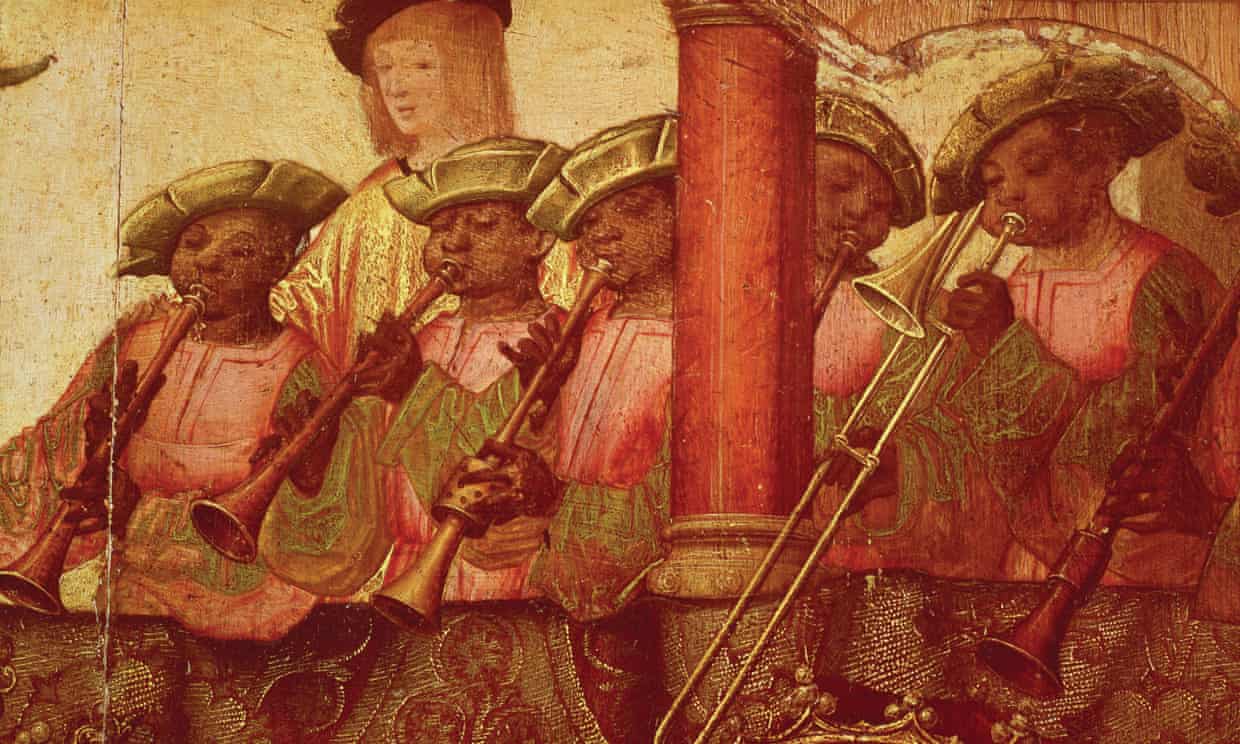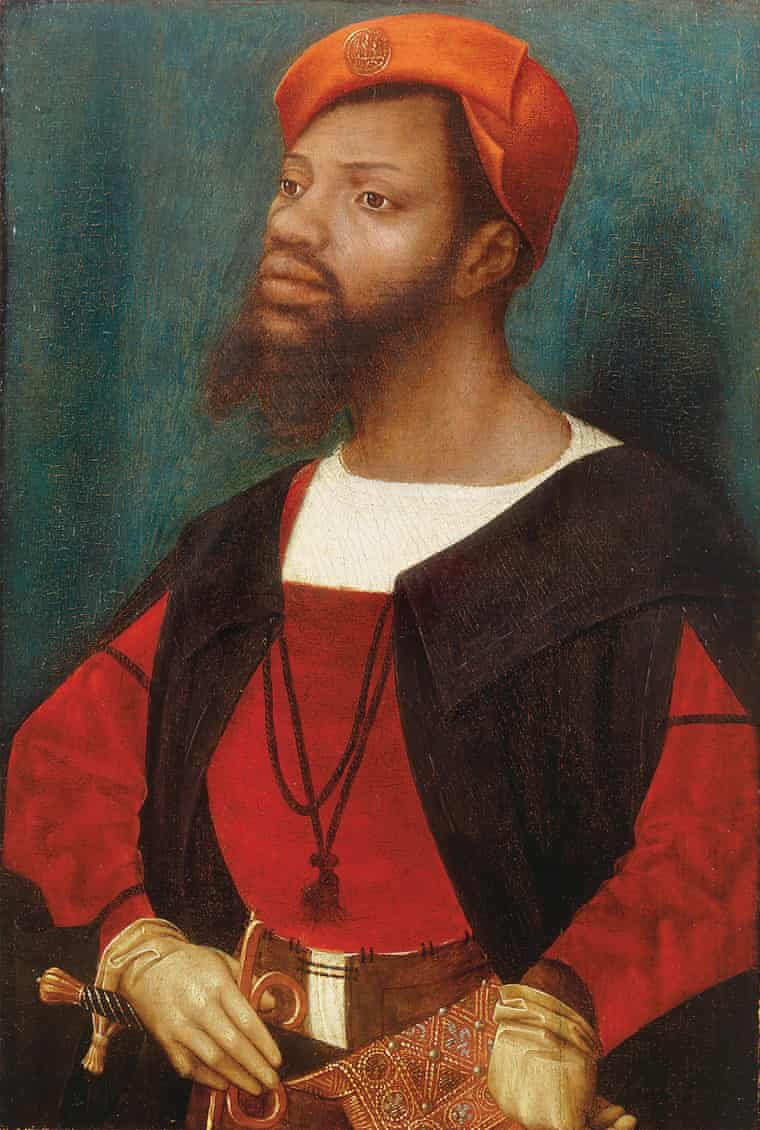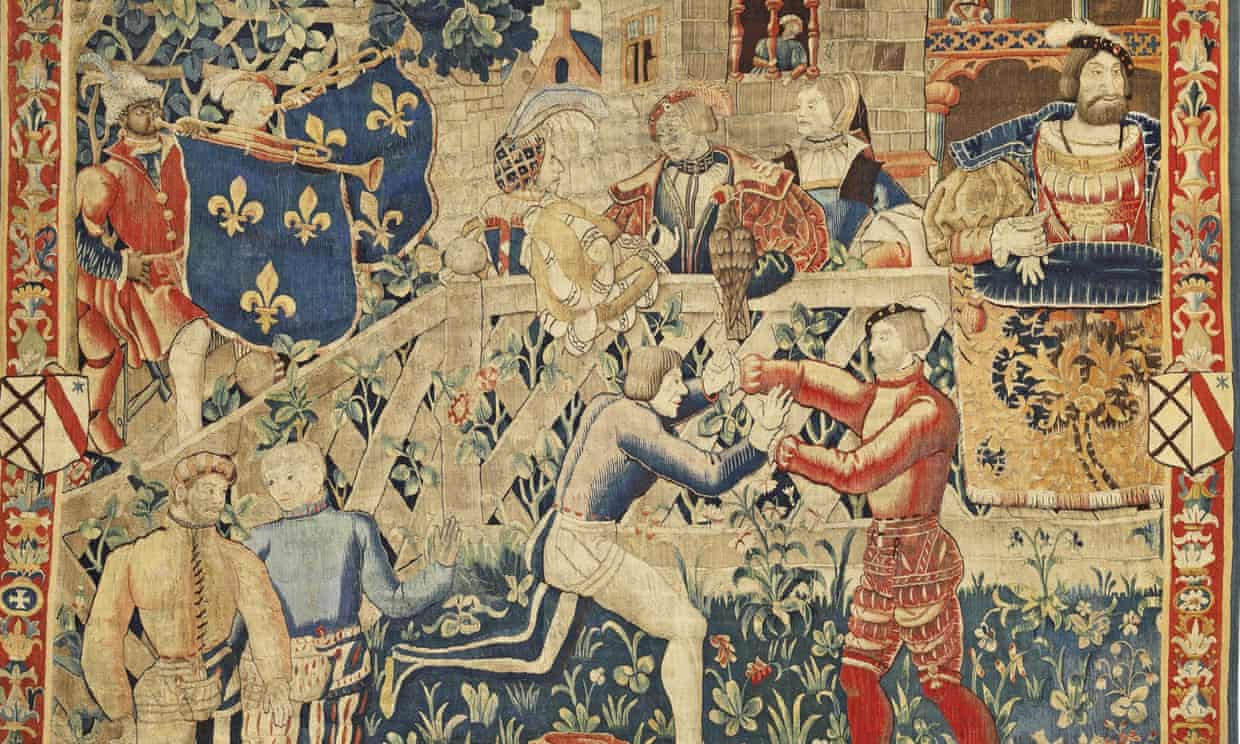
Black musicians in a Portuguese painting of The Engagement of St Ursula and Prince Etherius, c 1520. Photograph: Bridgemanimages.com
Within moments of meeting historian Miranda Kaufmann, I learn not to make flippant assumptions about race and history. Here we are in Moorgate, I say. Is it called that because it was a great hub of black Tudor life? “You have to be careful with anything like that,” she winces, “because, for all you know, this was a moor. It’s the same with family names and emblems: if your name was Mr Moore, you’d have the choice between a moorhen or a blackamoor. It wouldn’t necessarily say something about your race.”
Her answer – meticulous, free of bombast, dovetailing memorable details with wider issues – is typical of her first book Black Tudors: The Untold Story, which debunks the idea that slavery was the beginning of Africans’ presence in England, and exploitation and discrimination their only experience. The book takes the form of 10 vivid and wide-ranging true-life stories, sprinkled with dramatic vignettes and nice, chewy details that bring each character to life.
Africans were already known to have likely been living in Roman Britain as soldiers, slaves or even free men and women. But Kaufmann shows that, by Tudor times, they were present at the royal courts of Henry VII, Henry VIII, Elizabeth I and James I, and in the households of Sir Walter Raleigh and William Cecil. The book also shows that black Tudors lived and worked at many levels of society, often far from the sophistication and patronage of court life, from a west African man called Dederi Jaquoah, who spent two years living with an English merchant, to Diego, a sailor who was enslaved by the Spanish in Panama, came to Plymouth and died in Moluccas, having circumnavigated half the globe with Sir Francis Drake.
Kaufmann’s interest in black British history came about almost by accident: she intended to study Tudor sailors’ perceptions of Asia and America for her thesis at Oxford University, but found documents demonstrating the presence of Africans within Britain. “I’d never heard anything about it, despite having studied Tudor history at every level. When I went to the National Archive for the first time, I asked an archivist where to start looking and they were like: ‘Oh well, you won’t find anything about that here.’” Kaufmann kept digging, contacted local record offices and ultimately built up to her book. So why has the existence of black Tudors been unknown, untold and untaught? “History isn’t a solid set of facts,” she replies. “It’s very much about what questions you ask of the past. If you ask different questions, you get different answers. People weren’t asking questions about diversity. Now they are.”
Despite Kaufmann’s research, it is hard to swallow the idea that black people were not treated as extreme anomalies (or worse) in Tudor England. “We need to return to England as it was at the time,” says Kaufmann – “an island nation on the edge of Europe with not much power, a struggling Protestant nation in perpetual danger of being invaded by Spain and being wiped out. It’s about going back to before the English are slave traders, before they’ve got major colonies. The English colonial project only really gets going in the middle of the 17th century.” That said, she does leave a stark question hanging in the air: “How did we go from this period of relative acceptance to becoming the biggest slave traders out there?”
Black Tudors does not make overblown claims about ethnic diversity in England – in her wider research, Kaufmann found around 360 individuals in the period 1500-1640 – but it does weave nonwhite Britons back into the texture of Tudor life. Black Tudors came to England through English trade with Africa; from southern Europe, where there were black (slave) populations in Spain and Portugal, the nations that were then the great colonisers; in the entourages of royals such as Katherine of Aragon and Philip II (who was the husband of Mary I); as merchants or aristocrats; and as the result of English privateering and raids on the Spanish empire. “If you captured a Spanish ship, it would be likely to have some Africans on board,” says Kaufmann. “One prized ship brought in to Bristol had 135. They got shipped back to Spain after being put up in a barn for a week. The authorities didn’t know quite what to do with them.”
Although there was no legislation approving or defining slavery within England, it could hardly have been fun being “the only black person in the village” – such as Cattelena, a woman who lived independently in Almondsbury and whose “most valuable item … was her cow”. Nonetheless, Kaufmann uncovers some impressive lives, such as the sailor John Anthony, who arrived in England on a pirate’s boat; Reasonable Blackman, a Southwark silk weaver; and a salvage diver called Jacques Francis. Kaufmann points to them as “examples of people who are really being valued for their skills. In a later age, you get these portraits of Africans sitting sycophantically in the corner looking up at the main character, but they’re not just these domestic playthings for the aristocracy. They’re working as a seamstress or for a brewer. Even in aristocratic households they are performing tasks – as a porter, like Edward Swarthye, or as a cook – they are doing useful things, they get wages. John Blanke, a royal trumpeter, gets paid twice the average wage of an agricultural labourer and three times that of an average servant. They’re not being whipped or beaten or put in chains or being bought and sold.”

Portrait of a Moor by Jan Mostaert, early 16th century
I balk at the names black Tudors were given – Swarthye, Blanke, Blackman, Blacke – and at the idea that trudging out an existence as a Tudor prostitute, like Anne Cobbie, a “tawny Moor” with “soft skin”, is any great win for diversity. But it does seem that black Tudors are no worse off than white ones. At a basic level, they are acknowledged as citizens rather than loathed as outcasts. “It’s enormously significant, given how important religion was, that Africans were being baptised and married and buried within church life. It’s a really significant form of acceptance, particularly the baptism ritual, which states that ‘through baptism you are grafted into the community of God’s holy church’, in which we are all one body.”
Kaufmann says she feels “anxious, because people might not like” her book. “Part of it is the surprise element: people didn’t think there were Africans in Tudor England. There’s this fantasy past where it’s all white – and it wasn’t. It’s ignorance. People just don’t know these histories. Hopefully this research will inspire producers to get multiracial stories on our screens.”
Although she is very generous with her time, Kaufmann has been uneasy, even to the point of seeming dissatisfied, throughout our conversation. She goes cautiously silent when I try to link her concerns to current issues such as Brexit, racism or the rise of populist nationalism. Part of the reason might be wariness at the vicious online treatment meted out to women of expertise when they comment on current affairs or state a fact that goes against philistine fantasies. Earlier this year, the historian Mary Beard was the target of abuse for corroborating an educational film for children which showed a well-to-do black family living under the Roman empire.
This resistance to accepting a black history is not confined to the lower reaches of Twitter. The academic and novelist Sunny Singh has written about director Christopher Nolan’s film Dunkirk, which erased the presence of Royal Indian Army Services Corp personnel and lascars from south Asia and east Africa working for the British and, on the French side, Moroccan, Algerian and Tunisian troops from France’s colonies. The comedian Mark Gatiss was so disturbed by the presence of one black actor in the cast for a Doctor Who time travel episode he was filming that he sent a “very difficult” email to his bosses protesting that “there weren’t any black soldiers in Victoria’s army”. Rattled, he did his own research and discovered that there had indeed been one black soldier there, whereupon he relented.
Despite her work in filling in these historical blanks, Kaufmann laments the scarcity of complete evidence: “I wish they had kept diaries or preserved letters. Much as I’ve pieced together these lives, they’re not satisfying biographies where we know everything – more often, they are snapshots of moments.” Nonetheless, the tide is turning against the myth that England has always been a monoracial, monocultural, monolingual nation. Along with writers such as David Olusoga, Paul Gilroy and Sunny Singh, and institutions such as the University of York, which has launched a project investigating medieval multiculturalism, historians such as Miranda Kaufmann are bringing England to a necessary reckoning with its true history.

A black trumpeter in a detail of a tapestry commemorating the Field of Cloth of Gold, 1520. Photograph: Heritage Images/Getty Images
Continue for full article: Tudor, English and black – and not a slave in sight
Separate, unrelated blog on Black Nobility in Europe: http://afroeurope.blogspot.com/2009/10/black-history-black-european-nobility.html
